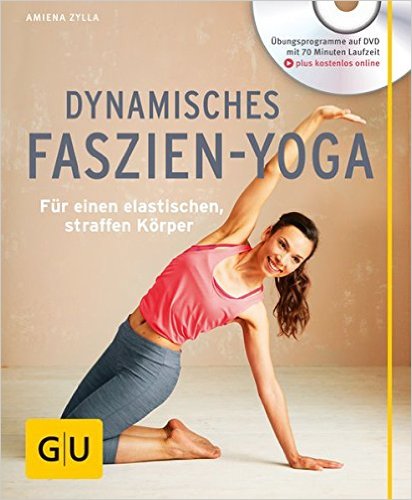An interview with Amiena Zylla

Fascia. With a little interest in exercise, fitness and body, you can hardly get past the new big topic, unless you live like me, secluded in a small Indian mountain village in the Himalayas.
During my recent visit to Germany, I naturally became curious about the ominous fascia, of which I had never heard of before and now read about it everywhere in every yoga and sports magazine.
Whether competitive athletes, yoga practitioners or my grandmother, everyone now seems to roll over the small foam roll and I want to know why and above all how to roll properly!
At the Yogaworld fair in Munich I had the opportunity to participate in Aminena Zylka’s fascia yoga workshop.
With more than twenty years of teaching and training experience in the fields of dance, gymnastics, pilates and yoga, Amiena Zylla has developed the dynamic fascia yoga with the fascia role, has written numerous books on the subject as a fascia expert and leads trainings and workshops in fascia yoga.
Overall, the workshop was very interesting but also a painful experience. Because fascia yoga hurts. While you roll out your whole body in different positions, you suffer sometimes more, sometimes less.

But that’s probably how it should be. Amienas is happy about our moaning in the workshop and just says: “Yes right! Now you release your bonding and after the class you will feel really good!”. In fact, I feel liberated to be off the roll after 90 minutes and admit that I don’t feel that bad. Although: Amiena’s announcements of bruises already worry me a little.
 U
U
To learn a little more about Amiena, fascia and especially fascia yoga, I took the chance to ask her a few questions:
Interview:
In your Fascia Yoga Class, you mentioned that you developed Fascia Yoga to give your students more freedom. How can you experience freedom through fascia yoga and why is the topic of freedom so close to your heart?
The fascia, our connective tissue, can be imagined as a full-body suit that holds us together and gives us our shape. Like a spider web, the fascia permeates our entire body and envelops muscles, organs, nerves, etc.
Intensive research has shown that fascia scants react to a variety of movements.
This is where my fascia yoga starts. Here we move away from classical orientations and more towards playful angle changes in order to stimulate more the collagen fibers that make up our fascia, among other things.
The playful orientation gives the yoga student more freedom in his practice.
The concept of being able to move freely within a structure has always been close to my heart. I think the issue of freedom is very much related to how I grew up. I grew up in South Africa during the apartheid system. My parents had a forbidden helic. Our family has always fought for the rights and freedom of the black and coloured population. The reason for our move to Germany in 1986 was mainly because we were so politically engaged and the government became aware of us. Since my dad is German, it made sense moving to Germany.
What distinguishes Fascia Yoga from a normal fascia workout?
The basis for fascia yoga is the classic asanas. However, we leave the alignment pretty quickly and play with as many angle changes as possible. Since the fascia contractes very strongly under the influence of stress, certain breathing exercises and relaxation techniques are just as important as the body exercises to reduce the stress level and thus keep the fascia more supple.
Why do you need the fascia roll and why do the exercises hurt with it?
The fascia roller is used for rehydration. With it, we dissolve congestion and ensure that fresh water flows again in the fascia. This dissolves tensions. Sometimes you can catch a spot in the body where these jams are particularly dense and the tissue is heavily matted. Rolling over these places can be quite painful. Or when the body is basically very tense.
How often and for how long should you do fascia yoga and with what intensity?
2-3 times a week with at least one day break in between, for an hour or so. But it doesn’t always have to be an hour. 10 minutes can be enough for you and every 2 days.
Is it possible to do something wrong with self-practice in fascia yoga?
Not in the sense that you get injured, but at most that you might be training with more muscle content, rather than with the fascia.
How can fascia yoga help with injuries?
Injuries often cause scarring. These scarring leads to the matting or bonding of the fascia tissue. With Fascia Yoga you can avoid these scarring at all or, once they are there, dissolve them.
The fascia sector is still very young and is constantly evolving with many new research findings.. How do you develop your fascia yoga accordingly?
Oh yes, I’m constantly on the subject and always let everything new flow into my classes immediately. My fascia yoga is constantly evolving. Almost every week new exercises are added.
Thank you for the conversation!

Amiena Zylla – a person like her name from A to Z and inventor of fascia yoga. She completed her extensive training in her birthplace Cape Town as well as in the USA, Germany and India. For more than 20 years she has been working with great passion as a yoga and Pilates teacher, dance teacher and nutritionist, modeling, writing books and passing on her knowledge as an expert for various TV (e.g. GNTM, ARD lunch buffet) and magazine formats (e.g. Elle, Madame, Spiegel, Shape) as well as on her Youtube channel. In 2016 she was one of the main testimonials of Vichy’s “Slow Age” campaign, and in 2017 she made yoga videos for the company “Alpro”. For more than 11 years she has run her own studio – “Amienas’s werkstatt” in the centre of Munich. The studio specializes in yoga, pilates, fascia and barre. Amiena trains yoga and fascia yoga teachers at home and abroad. Whether in front of the camera or live in class, her teaching style is charming and relaxed and leaves room for individuality for the participants. True to her motto “Let Your Body Smile®” the fun and joy of movement is always in the foreground.











